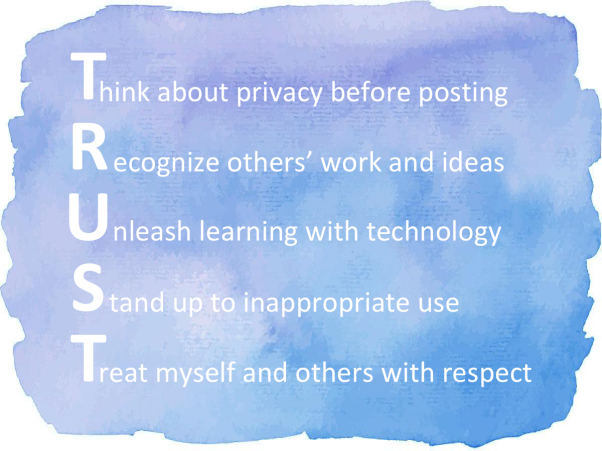
This post is part of a series about the Building Blocks for Personalized Learning. It is necessary for teachers to nurture the development of a Community within their classrooms in order to facilitate personalized learning. Each student needs to feel empowered within the learning environment to explore individual interests and passions. Consider the type of community in which you would thrive. How would you describe that environment? Generally, people describe an effective neighborhood community as friendly, supportive, secure, vibrant, participatory, and innovative. Designing this type of learning environment within each classroom is equally important. Students need to experience similar qualities in their classroom communities in order to achieve personal academic success.
Qualities of Community

Trust – I have previously blogged about the quality of trust (Learning to TRUST with Responsible Use) as my school district made the shift from an Acceptable Use Policy to Responsible Use Guidelines. When students are using technology tools and digital resources to engage in personalized learning activities, teachers have to be able to trust that students will be responsible. This TRUST poster provides five positive “I will…” statements to support the responsible use of technology tools and digital resources. As teachers begin a new school year, they should discuss each of these statements with their students and what they look like in practice. Trust involves developing an open, supportive, and vigorous classroom culture, so these items need to be reviewed regularly with the students.This includes ensuring safety and respect so that students feel comfortable enough to participate fully in personalized learning.
Inclusive – A classroom community is constructed of diverse individuals, but they can come together in the personalized learning environment and support each other with common goals. Each student should be encouraged to share their unique qualities and differences, as they pursue their own interests and individual learning paths. To develop a more inclusive learning environment, teachers can include various perspectives on topics. This approach provides students with an opportunity to see examples from many viewpoints. Diversity should be purposefully incorporated throughout the curriculum by using multiple examples, relevant content, and meaningful illustrations that are free of stereotypes. In this way, everyone is welcome within the classroom to contribute their personal strengths and abilities to benefit the whole community.
Responsive – When teachers possess a good understanding of their students, they should know when students might have personal challenges or difficulties that keep them from performing to their maximum potential. Knowing what makes each student tick helps a teacher become more responsive to their needs and personal differences. One way to develop this understanding is to conference with students regularly (ideally weekly) to set goals, design personalized learning paths, determine progress, and celebrate success. The feedback that teachers provide during these conferences should not only be for instruction, it should encompass the needs of the whole child. Likewise, when difficulties do arise, the teacher should have access to other resources within the school community to assist them in meeting each child’s individual learning needs.
Empowering – By empowering students to make relevant choices about the direction of their learning, teachers can help students become more involved within the classroom community. Encouraging students to believe that they have control over their success is an indicator of a growth mindset and could be one of the most important qualities a student can develop. Growth mindset is the concept that through dedication and hard work you can achieve anything. Carol Dweck wrote about the differences between a growth mindset and a fixed mindset in her book, Mindset: A New Psychology of Success. Essentially, one difference is that a student with a fixed mindset may quickly give up working on a challenging problem after a few minutes, but a student with a growth mindset will persist and view the problem as an exciting challenge! Students with a growth mindset will also learn to see themselves as the architects of their own success. Developing this understanding within students arises in part from ownership of the learning experience.
Joyful – The personalized learning environment is joyful as teachers and students share in the learning process. Even when situations become challenging, there is pleasure in discovering new solutions to problems and collaborating with others in the classroom community. Not only do students feel more connected to their teacher and each other, but they begin to feel more connected to the content they are exploring along their unique learning paths. It is essential to have opportunities to celebrate this joy of learning and each student’s personal successes and achievements. Hosting visitors to the classroom so that students can share what they have learned with others is a good strategy for showcasing success. Also, identifying ways that students can contribute what they have learned to benefit their school, neighboring community, or the world provides a more authentic learning experience and produces a sense of satisfaction and purpose.